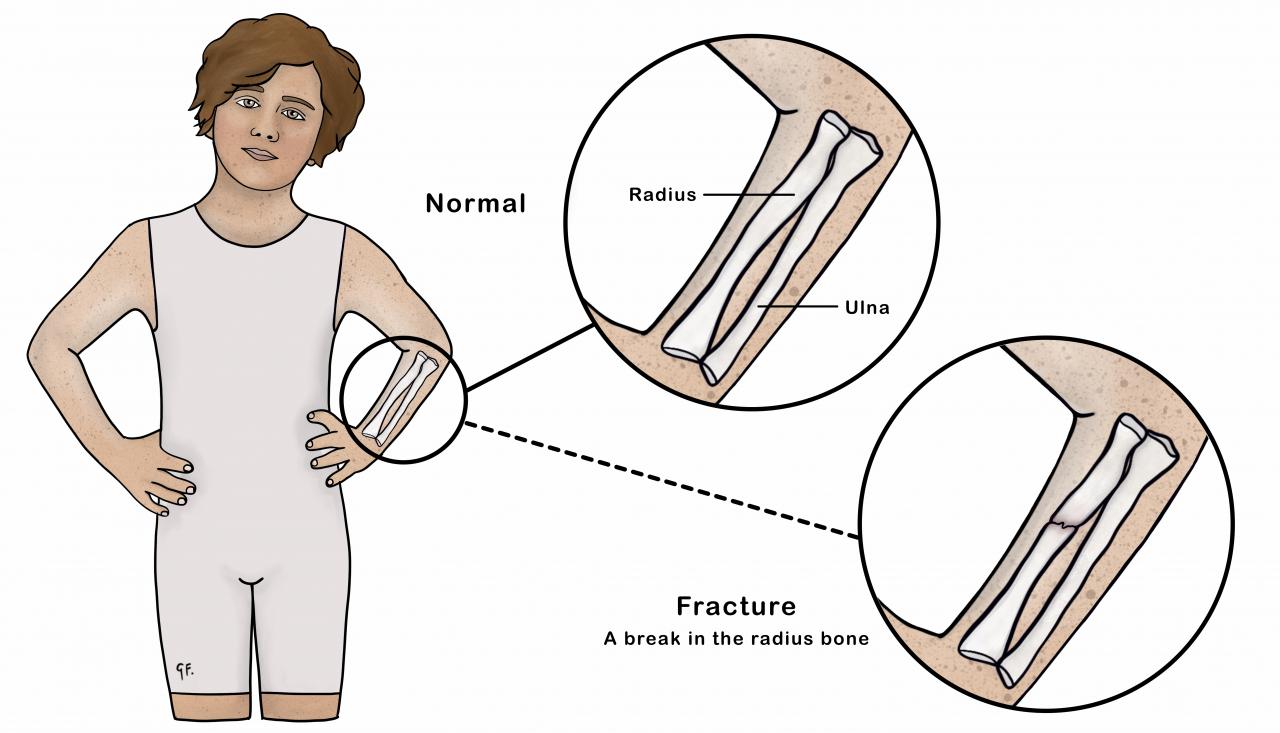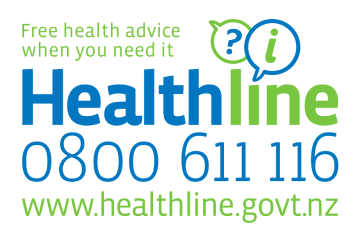Fracture
Fracture
There are many different types of fractures. Your child's treatment will depend on the type of fracture, and where it is.
Key points about a broken bone or fracture
- a fracture is a break in the bone
- there are different types of fractures
- your child's treatment will depend on the type of fracture, and which bone is broken
- your child will need to go to follow-up appointments with a health professional
- your child will often need more x-rays to check bone healing and position of the fracture
- which bone is broken and how severe the break is will affect how long the fracture takes to heal
Most tamariki (children) with simple fractures can have their treatment in the emergency department or urgent care centre and go home from there.
What is a fracture?
A fracture is a break in a bone. There are many different types of fractures that all have different names.
Closed fracture
There is a break in the bone but no damage to the skin or tissue.
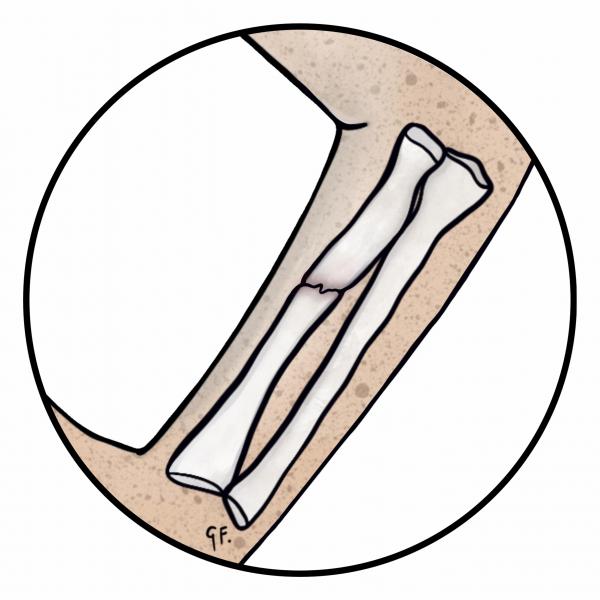
Open or compound fracture
There is a break in the bone with damage to the skin or tissues around the fracture. Having damage to the skin means there is a risk of bacteria getting into the wound. This can cause a bone infection.
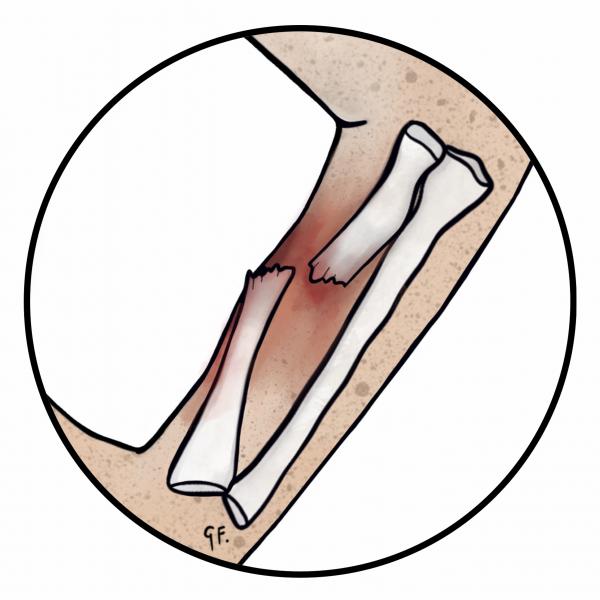
Greenstick, torus or buckle fracture
This is a common injury in tamariki because a child's bone can bend or buckle more easily than an adult's without completely breaking.
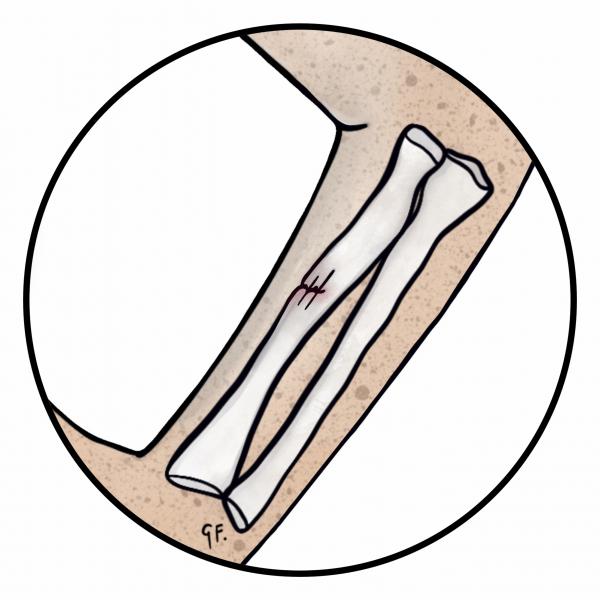
How is a fracture diagnosed?
Your child will need an x-ray to see:
- where the fracture is
- what type of fracture it is
- whether or not the bones are in line
See the KidsHealth page on x-rays to learn more
How can first aid help my child with a fracture?
Positioning
Keep the injured arm or leg still. You can support your child’s injured arm or leg with a pillow or sling. A splint can help keep the injured part still. Someone trained in first aid may be able to put a splint on your child.
Pain relief
Your child will need pain relief. You can give paracetamol or ibuprofen to make them more comfortable. Follow the dosage instructions on the bottle. It is dangerous to give more than the recommended dose.
If your child is in a lot of pain, call an ambulance.
What kind of treatment will my child have for their fracture?
Different fractures need different treatments. The health professional will discuss with you what treatment is needed for your child's fracture.
Plaster casts
Usually, the treatment for fractures in tamariki is a plaster cast. Sometimes, after a fracture, there can be swelling so your child may need a back slab (half a cast) for the first few days to weeks. When the swelling goes down, a health professional will put a carefully shaped plaster cast on to hold the bones in the correct position.
See the KidsHealth page on arm plasters or casts to read more
See the KidsHealth page on leg plasters or casts to read more
Manipulation to move the bones into a better position
If your child has a fracture where the bone ends are not lined up (displaced), a health professional may need to move the bones into a better position before putting on the plaster cast. This is called manipulation and your child will need sedation or a general anaesthetic to do this, along with further x-rays.
See the KidsHealth page on general anaesthetic in children to learn more
Surgery
Sometimes your child will need an operation to fix the fracture with screws, nails, plates or wires. This surgery is called an ORIF (open reduction and internal fixation) or CRIF (closed reduction and internal fixation). Your child will need a general anaesthetic.
Tamariki may need this surgery for the following fractures.
Fractures into a joint
This is called an intra-articular fracture.
Fractures involving a growth plate
This is called a physeal fracture. A growth plate (physis) is the cartilage or connective tissue at the ends of long bones in growing tamariki.
Fractures through abnormal bone
This is called a pathologic fracture.
Fractures where there is significant displacement
The bones can't be lined up (reduced), or they won't stay lined up after manipulation.
Fractures where there is a break in the overlying skin
This is called an open or compound fracture.
Traction
Sometimes, your child will need traction to keep the bone in position. This involves the use of pulleys, weights and bed rest and can help with pain relief while your child waits for surgery.
Will my child have to stay in hospital for their fracture treatment?
The amount of time your child is in hospital will depend on:
- the bone or bones involved
- the type of fracture they have
- the treatment they need
- how much pain relief they need
- how much swelling your child has
Most tamariki with simple fractures can have their treatment in the emergency department or urgent care centre and go home from there.
If the fracture is more severe, the orthopaedic team (bone specialists) will keep your child in hospital to watch the swelling and keep the arm or leg raised. They will also give your child stronger pain relief if they need it.
How long will it take for my child's fracture to heal?
Tamariki heal differently from adults. Your child's healing will depend on where the fracture is and how severe the break is. For example, a simple buckle fracture will need a plaster cast or splint for 2 to 3 weeks and be almost completely healed in 4 weeks.
Tamariki heal in about half the time it takes an adult to heal from a similar injury. Often, fractures in growing bones correct their own shape—they will 'remodel'. This means that even if your child's bones are not quite in line, they will usually straighten out with time. But, your child’s arm or leg may look slightly crooked or bent when the cast first comes off.
How can I care for my child with a fracture at home?
Raising your child's arm or leg
In the first few days, your child may have swelling and pain in their fractured limb. To reduce the swelling and discomfort when your child is resting, raise the limb by resting it on a pillow. Aim to have the injured limb above the level of your child’s heart.
A sling for arm fractures
If your child has a fractured arm, they should wear an arm sling or a collar and cuff when they are up and about.
Crutches for leg fractures
If your child has a fractured leg, they will need crutches, a walking frame or a wheelchair. In the first few days, your child should rest and keep their leg raised. They should only use crutches when getting up for short periods, such as going to the toilet. Follow the instructions of the health professionals looking after your child.
Pain relief
Your child will usually need pain relief for the first few days after going home from hospital. A health professional should talk to you about pain relief before you go home.
Returning to normal activities
Ask the health professional when it will be OK for your child to return to normal activities such as school and sports. This will depend on what bone was broken, the type of fracture and the treatment your child had.
When should I seek help for my child's fracture?
After going home, you should take your child back to the emergency department or contact your medical team urgently if your child:
- complains of pain that is getting worse even with pain relief and raising the broken arm or leg
- has a hand or foot that is going cold, pale or blue
- has a hand or foot that is becoming more swollen
- complains of fuzziness, numbness, pins and needles or tingling in the fractured arm or leg or in their toes or fingers
- cannot move their toes or fingers
If your child's plaster becomes cracked, broken, soft, or loose, or it rubs, contact a health professional.
If it is a leg plaster, your child should not walk on it. They should use crutches, a walking frame or a wheelchair unless you have been told you can walk on it by the health professionals looking after your child.
What follow-up does my child with a fracture need?
It is very important that your child goes to all their follow-up appointments.
Your child will usually need a fracture clinic appointment 5 to 14 days after leaving hospital. At this appointment, your child may have another x-ray to make sure the bone is healing and is lined up. Your child will usually need several more appointments at a fracture clinic to make sure the break is healing.
Ask a health professional for instructions for your child's follow-up before you leave hospital.
This page last reviewed 20 September 2024.
Do you have any feedback for KidsHealth?
If you have any feedback about the KidsHealth website, or have a suggestion for new content, please get in touch with us.
Email us now